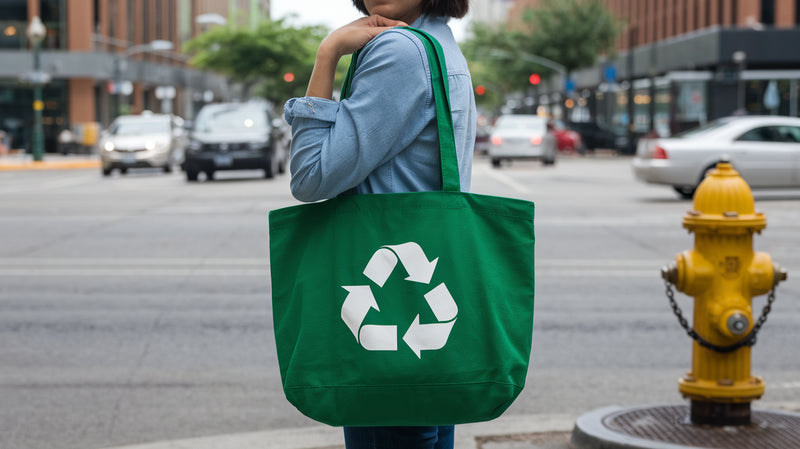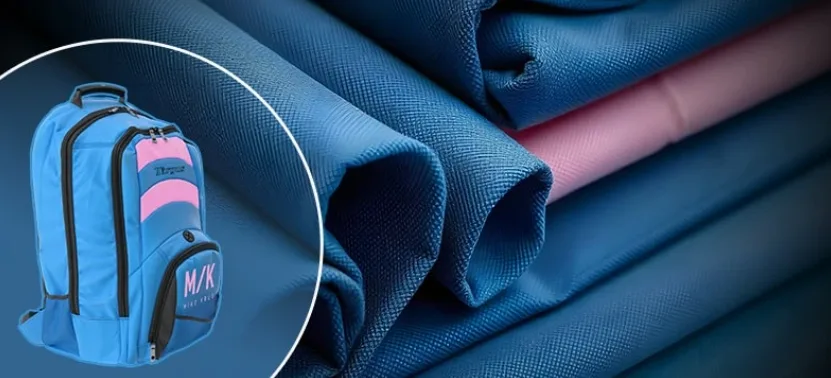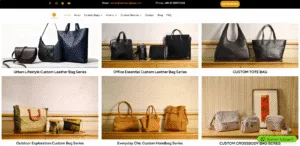As a bag manufacturer, I look at several key things when choosing materials for reusable bags. Considering these points helps me make sure the bags are strong, eco-friendly, brandable, affordable, and meet user needs.
Contents
Custom Bag’s Material Durability and Strength

A material with high toughness typically exhibits both strength and ductility; for instance, thermoplastic polyurethane (TPU) demonstrates excellent impact resistance and elasticity, with elongation at break often exceeding 500%, making it ideal for applications requiring both flexibility and durability.
During a major promotional campaign, I was tasked with creating tote bags that were both stylish and durable enough for daily metro commutes and grocery runs. I chose canvas, jute, and hemp—materials known for their toughness and character. One user told me her canvas bag “carried her whole life” for years and still held its shape without sagging.
In another project for a tech fair, the client needed lightweight giveaway bags to hold brochures and samples. I recommended nonwoven polypropylene (PP)—a cost-effective, flexible material that’s stronger than it looks. Attendees appreciated the smooth texture and durability for carrying various items throughout the event.
Recommended Materials:
Canvas / Jute / Hemp: Best for heavy-duty, reusable, everyday bags
Nonwoven PP: Ideal for large-scale giveaways with a focus on budget and practicality
So, here’s my guideline: Use the workhorses—hemp, jute, and canvas—for demanding tasks. Choose nonwoven PP for lighter projects where cost is a key factor. Your end users will notice the difference in quality and feel.
Bag’s Environmental Impact

Many eco-friendly materials have a significantly lower impact on the planet. Biodegradable and renewable fiber backpacks, like cotton and jute, decompose naturally, reducing landfill waste. Organic cotton further limits environmental harm by avoiding synthetic pesticides, while jute grows quickly with minimal water and chemical input, making it one of the most sustainable natural fibers. Meanwhile, RPET (recycled polyester) reduces energy consumption by up to 66% compared to virgin plastic, making it an ideal material for Reusable Bags that help lower both environmental and production costs.
In one project, Sunteam collaborated with a client to design a sustainable backpack made from a vegan leather bag and RPET lining. The client wanted an urban, minimal look while staying true to their eco-conscious brand values. By using recycled and cruelty-free materials, we were able to reduce the bag’s environmental footprint without compromising on style or function.
Recommended Materials:
Organic Cotton / Jute: Biodegradable and renewable; great for natural-looking, sustainable bags
RPET / Recycled Cotton: Ideal for reducing landfill waste and promoting circular design
Vegan Leather: A cruelty-free alternative to traditional leather, often made with lower-impact processes
Being eco-friendly is very important to me. I prefer materials that are biodegradable, renewable, vegan leather bags, and compostable.
Cost-Effectiveness of RPET Bag

From a cost-efficiency standpoint, a nonwoven polypropylene (PP) bag manufacturer stands out for its low production costs, lightweight structure, and ease of mass manufacturing, making it ideal for large-scale promotional use. Jute, a natural fiber, is also highly affordable due to its fast-growing nature and minimal cultivation needs. Meanwhile, RPET (recycled polyester) reduces energy consumption by up to 66% compared to virgin plastic, lowering both environmental and production costs.
My recommendation: For budget-conscious projects that still aim for functionality or sustainability, I recommend nonwoven PP, jute, and RPET as cost-effective material choices.
Customizability and Branding

Over the years of working with promotional products, I’ve found cotton and nonwoven polypropylene to be two of the most print-friendly materials available. Cotton handles screen printing exceptionally well—the colors stay vibrant, and the soft texture gives a premium feel. Nonwoven polypropylene, on the other hand, is ideal for heat transfer and dye-sublimation printing. It dries quickly, resists wrinkles, and keeps colors sharp even on detailed designs.
One standout project was a bulk tote bag order produced in our Bangladesh bag factory for an international trade show. We used nonwoven polypropylene to print 10,000 units with complex graphics under a tight deadline. The fast-drying ink and smooth material surface helped maintain quality throughout production and packaging.
My recommendation: This and many other successful projects, I confidently recommend cotton and nonwoven polypropylene for clients who need practical, visually impressive solutions.
Cleaning and Maintenance

Easy-to-clean materials play a crucial role in sustainability. A reusable bag manufacturer is only truly eco-friendly if they last through repeated use, and proper maintenance extends their lifespan. Machine-washable fabrics help keep bags fresh and hygienic, encouraging consumers to reuse them instead of discarding them prematurely.
Cotton bags stand out in this regard—they can be tossed into the washing machine, making them a convenient and durable option for everyday use. In contrast, materials like polypropylene (PP), recycled PET (RPET), and nylon are not suitable for machine washing and require gentle hand cleaning.
If you’re looking for high-quality, customizable reusable bags in bulk, feel free to contact Sunteam for tailored solutions.
Comparison Table: Key Material Selection Criteria
Expert Opinion:
“I think this comparison table is a great tool. It helps people choose materials for reusable bags. Based on my 15+ years working with sustainable textiles, I know no single material works for everything. The key is matching material properties to specific use cases. For example, organic cotton is very durable and offers good branding potential. I suggest it for high-quality promotional items, even though it costs more. On the other hand, nonwoven polypropylene is a popular choice for large orders when cost is a major factor. Many businesses use it. I believe this analysis is valuable because it looks at the whole picture. It considers cost, environmental effects, and how practical the bags are to use. I also recommend manufacturers think about their local supply chains when choosing materials. Having reliable local sources has become more important recently.”
———— Dr. Sarah Bennett , Sustainable Materials Specialist. I have 15 years as a Textile Industry Consultant focused on environmentally friendly manufacturing.
| Material | Durability | Biodegradable | Renewable | Cost | Branding/Print | Cleaning | Energy Use |
|---|---|---|---|---|---|---|---|
| Cotton/Organic | High | Yes | Yes | Moderate-High | Excellent | Machine washable | Moderate |
| Recycled Cotton | High | Yes | Yes* | Moderate | Excellent | Machine washable | Lower (recycled) |
| Jute | High | Yes | Yes | Low | Good | Limited | Low |
| Nonwoven Polypropylene | Moderate | No | No | Low | Excellent | Not recommended | Low |
| RPET | High | No | No | Moderate | Good | Not recommended | 2/3 lower vs PET |
| Nylon | High | No | No | Moderate | Good | Not recommended | High |
As environmental awareness grows, customers are placing greater importance on materials that balance functionality and environmental impact Reusable Bags. One standout example is RPET—made from recycled plastic bottles. I once worked on a campaign that highlighted how RPET production uses about two-thirds less energy than creating virgin PET. Touring the factories, I was struck by how discarded bottles are transformed into strong, reusable fibers. It’s a real-world example of the circular economy in action, and every project using RPET feels like a small win for the planet.
Another memorable project involved launching jute bags for a grocery chain. Jute requires minimal water and chemicals to grow, and customers loved the bags’ earthy texture and natural scent. Feedback praised their durability and eco-friendly appeal, especially the fact that jute is biodegradable. Choosing jute isn’t just a design decision—it’s a message about values.
Across projects, clients consistently comment on the quality, bold colors, and print clarity of our materials—from soft, certified organic cotton canvas to reliable nonwoven polypropylene. One client told us, “The logo looks amazing, and the bag holds its shape beautifully.” Another said, “Our commuters love the thick organic cotton—it’s chemical-free and feels great to the touch.”
Looking to create bags that align with your brand’s values? Let’s work together to design solutions that are practical, beautiful, and sustainable. Reach out today to explore your options.
Summary
Looking ahead, my commitment is to balance cost, how long a bag lasts, and its environmental effect for every bag I make. And finding this balance is key. The best material choice depends entirely on what each project needs. For instance, I might recommend a strong canvas for an everyday bag. Lightweight PP could be a good fit for promotional event bags. I will keep evaluating these factors for each situation. My goal hasn’t changed: I aim to create reusable bags that people find useful, while also being kind to our planet. As a dedicated bag manufacturer, I hope that in my own small way, my efforts contribute to building a more sustainable future for all of us.
As a bag manufacturer, I weigh these criteria carefully. I aim to align my material choices with the needed durability, sustainability goals, branding requirements, and the price point for the specific market and intended use of the bag.
FAQ About Choosing Materials for Reusable Bags

1. What are the most eco-friendly materials for reusable bags, and why do they matter?
Eco-friendly materials like organic cotton, recycled PET (rPET), hemp, and biodegradable PLA are popular choices. They help reduce environmental impact by lowering carbon footprints, minimizing plastic waste, and often being biodegradable or recyclable travel bags.
2. How do I balance durability and sustainability when choosing bag materials?
I consider how long a material will last versus how sustainable it is. For example, canvas offers excellent durability and is made from natural fibers, while non-woven PP is less durable but recyclable and cost-effective. The key is matching the material to the product’s intended use and target customer.
3. What role does end-of-life disposal play in material selection?
It’s a big part of my decision. I prefer materials that are recyclable or compostable to ensure minimal landfill waste. I also consider whether the material can be reused or repurposed, supporting a circular lifecycle for the product.
4. How do customer preferences and branding impact your material choices?
Customer values vary. Eco-conscious clients often prefer natural or recycled custom bag materials, while luxury brands may prioritize texture and finish. My goal is to align the material’s look, feel, and sustainability with the brand story and customer expectations.
5. What testing or certifications do you rely on to ensure material quality and sustainability?
I look for certifications like GOTS (Global Organic Textile Standard), GRS (Global Recycled Standard), OEKO-TEX, and FSC. These help ensure that the materials meet strict environmental and safety standards, giving both my team and clients peace of mind.






